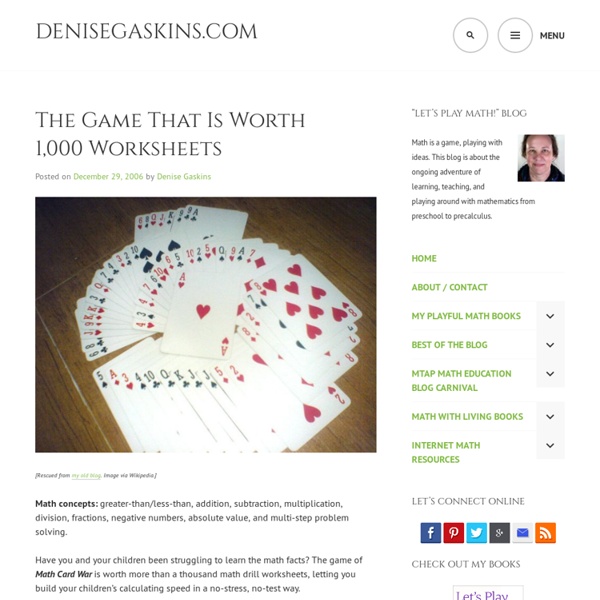550 Free Audio Books: Download Great Books for Free
Download a Free Audiobook from Audible and also AudioBooks.com Download hundreds of free audio books, mostly classics, to your MP3 player or computer. Below, you’ll find great works of fiction, poetry and non-fiction, by such authors as Twain, Tolstoy, Hemingway, Orwell, Vonnegut, Nietzsche, Austen, Shakespeare, Asimov, HG Wells & more. Also please see our related collection: The 150 Best Podcasts to Enrich Your Mind. Fiction & Literature
Number Sense
How many Peeps are sold at Easter time each year? Treat your students to some authentic and delicious math as they estimate, consider reasonability, determine necessary info, problem solve and conduct random samplings. The activity, hints and data are below. CCSS: 7.SP.1,… Read more → That’s Jerry, my nephew, waving. Read more → It happens to me every year. Read more → Passover begins this year on Monday evening, April 14th, with a Passover seder dinner. Read more → Northern Chili and Los Angeles, California have experienced recent earthquakes. Read more → In this activity students decide how to divide 2 pizzas amongst 6 adults and 3 pizzas amongst 8 kids. Read more → We have two classic puzzles for your April 1st class starters. Read more → Based on this data, which do you think is the greatest March Madness program ever? Read more → Its time to go get the latest iPhone, the 5s. Read more → Read more → One Billions Dollars for The Perfect Bracket? Read more → During the St. Read more → Read more →
7 Fun and Engaging Video Projects for the ESL Classroom | Emerging Education Technologies
In most ESL classes, there comes a time when students must prove their oral skills, either through a speaking exam or an oral presentation. Traditionally these are done orally in front of the class, but using video for the oral presentation may help to calm some nerves and allow for a lot of creativity on the student's part. It's up to the teacher to assign a project that works for the level, assesses the target grammar or vocabulary, and gives the student a chance to demonstrate their progress in a creative and fun way. Here are seven fun and engaging video projects for ESL learners: 1. We've all seen those late night infomercials that go on and on about how desperately we need some silly contraption. 2. Involving literature and pop-culture into ESL classes is always a good idea because it's usually something the students are familiar with, which makes them feel enthusiastic and comfortable, despite the language barriers. 3. 4. 5. 6. 7.
Overview | LMR - Development Site
Learning Mathematics through Representations (LMR) is a research-based curriculum unit for the teaching and learning of integers and fractions in the elementary grades, using the number line as the principal representational context. The curriculum builds on two core ideas: mathematical representations are fundamental to mathematical communication and learning, and curriculum units should be designed as well-orchestrated lesson sequences that support insight and understanding of representational forms. The members of the LMR staff bring expertise in developmental and educational research, curriculum development, pre-service education and professional development, and elementary classroom teaching. Use the menus above to explore the following links: Research & Dev: Provides background information and the design principles, which guided the development of the LMR curriculum.Curriculum: Offers various ways of exploring and downloading the LMR curriculum.
A Collection Of My Best Resources On Teaching English Language Learners
I have an insane amount of resources on this blog related to teaching English Language Learners. I thought readers might find it useful if I put together a collection – in one post – of the materials I have either written or brought together (I’ll be posting a similar collections on student motivation and another one on parent engagement, two of the other topics I’ve written about a lot) Here goes: I’ll have to start with All My NY Times Posts For English Language Learners – Linked With Descriptions. I’ve written nearly thirty posts for the British Council, the largest organization promoting English-language teaching and learning around the world, and you can see a list of them – with links – here. I’ve authored or co-authored four books on teaching English Language Learners, and a fourth one will be published next April. The ELL Teacher’s Toolbox: Hundreds of Practical Ideas to Support Your Students was published in 2018. Navigating The Common Core With English Language Learners Related
Eight Ways To Help English Language Learners Feel Motivated To Read & Write
By Larry Ferlazzo This post will share a few ideas on how to specifically create those kinds of conditions to promote student interest in reading and writing. Researchers have identified four primary ways to nurture this kind of intrinsic motivation: Supporting students to feel a greater sense of autonomy. So, what can these elements look like in literacy instruction? Autonomy can be promoted by: Providing students choice in independent reading. Some ways to help students feel like they developing more skills include: Regularly giving “Low-stakes” formative fluency assessments (where students read a short passage to a teacher for a minute, who then tracks the number of words read and their level of “prosody”) can be done regularly and then students can see their own progress. Students can see that reading and writing can be connected to their lives in many ways, including: When it comes to helping students feel like reading and writing (and speaking and listening!)



